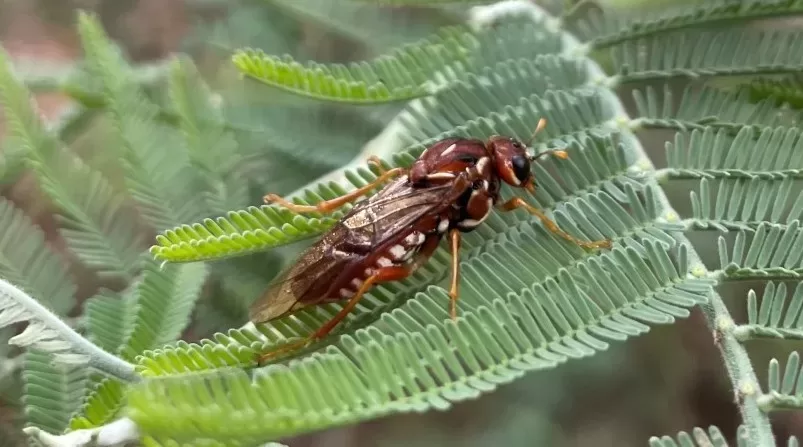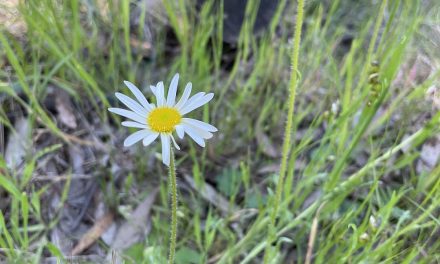Tanya Loos
Spitfires are a well known but somewhat mysterious feature of the Australian bush. What are they? Particularly tough caterpillars? They are actually the young of an insect called a sawfly – which is not a fly at all but a benign relative of wasps.
There are about 200 species of sawfly in Australia. Some feed on Eucalypts, others on teatree and bottlebrush. The species we see most commonly here in the Wombat Forest and surrounds is the Spitfire Sawfly – Perga affinis. The larvae come in two colour forms – steel blue black or a fawn colour and are most often seen on their favoured food plant – Eucalypts!

Gang-gang Cockatoos do not seem disturbed by the noxious fluid produced by Spitfire Sawflies and will happily munch their way through a whole group! (Photo: Carol Booth)
The name spitfire comes from their protective mechanism of exuding a noxious fluid when disturbed. The fluid is actually plant oils from the Eucalypts that are stored in a special area in their oesophagus – ready for squirting if they are under attack. This works on most animals – with the wonderfully quirky exception of Gang-gang Cockatoos who do not seem disturbed whatsoever by the fluid and will happily munch their way through a whole group!
Sawflies are named after the way the eggs are laid. When it is time to lay, a female will find a leaf and rub her abdomen and ovipositor over it for ages to prepare the leaf surface- then she will “saw” her way in to lay the eggs in between the leaf layers. I saw this once – a female sawfly just working an area of a messmate leaf for ages! They do this for several hours so I did not wait to see the egg laying…
The adults are not often seen – and pretty much all adults are females as they reproduce via parthogenesis. It is thought that evolutionarily they are older than bees and wasps – the ancestor insect for the bee and wasp family (Hymenoptera).
After hatching the sawfly larvae get down to the very important business of eating as much leaf matter as they can. They group together in larval colonies on branches during the day, and at night they fan out to feed on foliage. When it is time to move they travel along the ground in very tight knit groups. These colonies may be made up of young sawflies from different mothers, as there is safety in numbers.

Fawn coloured sawfly larvae on the move. (Photo: Tanya Loos)
The larvae communicate with one another in two ways – via tapping, which involves tapping their tail ends, or by whole body vibration via contraction of their whole bodies. The young carry out these communication strategies to keep the group together and also in the build up to any movements between feeding areas.
When they have eaten as much as they can and their bodies are huge and plump, it is time to pupate. They go to ground and bury themselves in the leaf litter and soil, often below the tree they were last feeding on. The young sawflies may enter a state of diapause for one to four years before maturing and then emerging! But most sawflies complete their life cycle within 12 months.
Some folks freak out when they see the defoliating activities of sawflies on their favourite garden eucalypt, but the trees recover well, and really – it’s so cool to host such a strange and fascinating member of our eucalypt forests in our own gardens.
Tanya Loos is a local naturalist, author and environmental consultant who loves to work in the environmental not-for-profit sector. She is the author of “Daylesford Nature Diary” available from her website or from Paradise Books in Vincent Street, Daylesford.
Have you got any nature questions for Tanya? Send them in!











